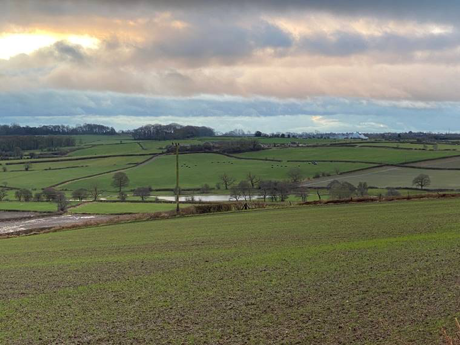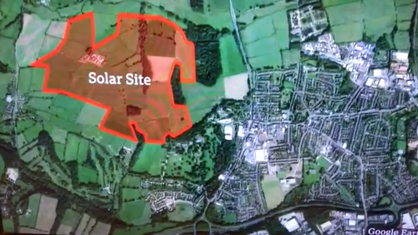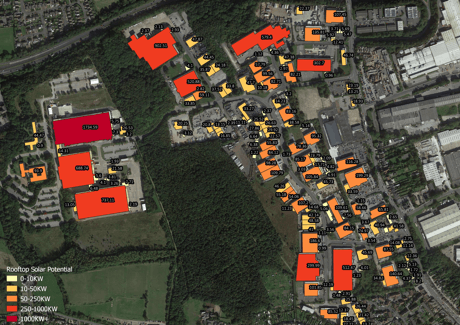The Solar Farm Debate - A National Issue
With a technology breakthrough making commercial and industrial rooftops a viable solar alternative for large-scale solar, do we need utility-scale solar farms on sensitive greenfield sites?
Landscape before solar and Landscape after solar
The proposed solar site will occupy over 300 acres of green fields.
Visualisation of solar film on commercial and industrial buildings
Save Alfreton Countryside community action group spokesperson
“We are responsible environmentalists; that’s why we are advocating credible alternatives to ground-mounted solar farms. When the planning application was submitted for a solar farm that would engulf 300 acres of green fields adjacent to Alfreton we wanted to put forward a positive alternative rather than simply protesting. Our local MP and the leader of Derbyshire County Council have spoken out against the development and expressed their preference for putting solar on industrial buildings. When we saw what Power Roll were doing it just seemed like the perfect solution as it’s lightweight, flexible and cost effective solar. Being a British company championing new technology we felt was a strong message as the profits will stay in the UK, which is not the case for the solar farm proposal.”
Derbyshire CPRE
This is an extract from CPRE Derbyshire’s report into the planning application:
“Having conducted an extensive site visit at both the Hall Farm, Alfreton and the Delves Farm, Shirland proposed solar development locations and reviewed all the relevant documentation, it is our considered opinion that both applications should be refused. … the detrimental impact on what is clearly high value landscape is unacceptable.”
Ian Dee, Chief Executive, Energeo
“We looked at potential C&I capacity across the top 25 conurbations, and we believe just in these areas there are over 250,000 buildings with a capacity of at least 50 kilowatts. Nationally, we think there are between 150,000 and 175,000 buildings that could hold at least 100 kilowatts. As can be seen from the Alfreton data though, even in a small area those capacities varied and some of the roofs could generate as much as 1.7 megawatts. Because many industrial buildings are simple, pre-fabricated structures, the key to unlocking this rooftop solar potential is lightweight solar film that is cheap to produce and install. Power Roll’s flexible film is an ideal solution.”
Neil Spann, Chief Executive, Power Roll
“The public is very supportive of solar PV, but that may change if we continue to pursue mega-scale projects that use hundreds of acres of greenfield land. We do, however, have a lot of ‘big sheds’ in the UK and that means a lot of roof space with the potential to accommodate solar on the scale we need to achieve net zero. Solar film technology can enable that.”
Nigel Mills, Amber Valley MP
“This is land which has great community value with all the footpaths running through it. I’m not convinced farms such as this are the right location for solar panels. I have never been a fan of solar farms; instead, solar panels should be on every building we can put them on. Otherwise, we should be developing brownfield sites. This application does not look to be a very attractive use of the land and my instinct is that this is a very bad idea. This is countryside and the idea of countryside is we keep it open.”
The national picture:
Developers and planners of new solar sites are continuing to operate at a “frantic pace”, according to research by Solar Media. The cumulative pipeline of UK solar farms has reached 11.6 GW across 469 sites, which includes 4 GW of new sites being scoped or put into full application during 2020. Typically, developers require about 5 acres (2 hectares) of land per megawatt of solar power, which means an average 50 MW solar farm can occupy 250 acres of land, or more if spacing is required to prevent shading.
How much solar do we need?
In terms of solar capacity needs for the UK, estimates vary. The latest Committee on Climate Change (CCC) report quoted 75 – 90 GW to achieve net zero, while National Grid’s Future Energy Scenario 2020 suggests we need 1.4 GW of solar every year until 2050, which equates to an additional 42 GW over 30 years.
Is commercial and industrial roofspace a credible alternative to ground-mounted solar?
According to the
BRE National Solar Centre, there are around 250,000 hectares (2.5 billion square meters) of south-facing commercial roof space in the UK. This could support over 400 GW of solar power using solar film; well in excess of the latest estimates of the capacity required to deliver net zero.
Related Pages
-
Alternative Solution
Find out more -
Why Say No
Find out more -
How to Object
Find out more
All Rights Reserved | Save Alfreton Countryside Action Group






